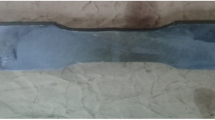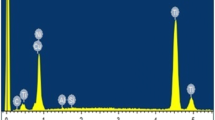Abstract
Adaptive neural network-based fuzzy inference system (ANFIS) is an artificial intelligent neuro-fuzzy technique used for modeling and control of ill-defined and uncertain systems. The present paper proposes this novel technique of ANFIS to predict the tensile strength of inertia friction-welded tubular pipe joints with the aid of artificial neural network approach combined with the principle of fuzzy logic. The proposed model is multiple input–single output type of model which uses rotational speed and forge load as input signals. The set of rules has been generated directly from the experimental data using ANFIS. The performance of the proposed model is validated by comparing the predicted results with the actual practical results obtained by conducting the confirmation experiments. The application of χ 2 test confirms that the values of tensile strength predicted by proposed ANFIS model are well in agreement with the experimental values at 0.1 % level of significance. The proposed model can also be used as intelligent online adaptive control model for pipeline welding.
Similar content being viewed by others
References
Yapp D, Blackman SA (2004) Recent developments in high productivity pipeline welding. J Braz Soc Mech Sci Eng XXVI(1):89–97
Vairis A, Frost M (1998) High-frequency linear friction welding of a titanium alloy. Wear 217:117–31
Sahin AZ, Yiba BS, Ahmed M, Nickel J (1998) Analysis of friction welding process in relation to the welding of copper and steel bars. J Process Technol 82:127–36
Zhang LW, Pei JB, Zhang QZ, Liu CD, Zhu WH, Qu S, Wang JH (2007) The coupled FEM analysis of the transient temperature field during inertia friction welding of GH4169 alloy. Acta Metall Sin (Engl Lett) 20(4):301–306
Yang L. Modeling of the inertia welding of inconel 718. PhD Thesis. The University of Birmingham; January 2010
Leis B N, Eiber R J. Stress-Corrosion Cracking on Gas-Transmission Pipelines: History, Causes and Mitigation, Proceedings of First International Business Conference on Onshore Pipelines, (Berlin, December 1997)
Zadeh LA (1973) Outline of a new approach to the analysis of complex system and decision processes. IEEE Transact Syst Man Cyber 1:28–44
Jang JSR (1973) ANFIS: adaptive-network-based fuzzy inference system. IEEE Transaction on Systems Man and Cyber 23:665–685
Lei Y, He Z, Zi Y (2007) A new approach to intelligent fault diagnosis of rotating machinery. Expert Syst Appl 35:1593–1600
Buragohain M, Mahanta C (2008) A novel approach for ANFIS modeling based on full factorial design. Appl Soft Comput 8:609–625
Ying LC, Pan MC (2008) Using adaptive network-based fuzzy inference system to forecast regional electricity loads. Energy Convers Manag 49:205–211
Avci E (2008) Comparison of wavelet families for texture classification by using wavelet packet entropy adaptive network based fuzzy inference system. Appl Soft Comput 8:225–231
Sengur A (2008) Wavelet transform and adaptive neuro-fuzzy inference system for color texture classification. Expert Syst Appl 34:2120–2128
Ubeyli ED (2008) Adaptive neuro-fuzzy inference system employing wavelet coefficients for detection of ophthalmic arterial disorders. Expert Syst Appl 34:2201–2209
Gill SS, Singh J (2009) Modeling of material removal rate in ultrasonic drilling of alumina ceramic by fuzzy logic. Int J Mechatronics and Manufacturing Systems 2(5/6):552–565
V.I., Friction Welding of Metals, AWS, Newyork, (1962)
Author information
Authors and Affiliations
Corresponding author
Rights and permissions
About this article
Cite this article
Gill, S.S., Singh, J. Artificial intelligent modeling to predict tensile strength of inertia friction-welded pipe joints. Int J Adv Manuf Technol 69, 2001–2009 (2013). https://doi.org/10.1007/s00170-013-5177-5
Received:
Accepted:
Published:
Issue Date:
DOI: https://doi.org/10.1007/s00170-013-5177-5




